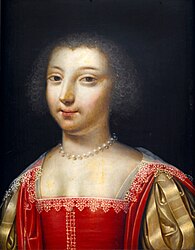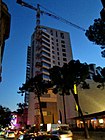Fichier:Ducayer - Portrait of a Lady, Uncertainly Identified as Anne de Bretagne, or her sister, Marie d’Avagour.jpg

Fichier d’origine (503 × 644 pixels, taille du fichier : 243 kio, type MIME : image/jpeg)
Ce fichier et sa description proviennent de Wikimedia Commons.
Description
| Jean Ducayer : Portrait of a Lady, Uncertainly Identified as Anne de Bretagne, Demoiselle de Goëllo (c. 1620/25-1707), or her Elder Sister, Marie d’Avagour de Bretagne, Duchesse de Montbazon (1611/12-1657)
|
|||||||||||||||||||||
|---|---|---|---|---|---|---|---|---|---|---|---|---|---|---|---|---|---|---|---|---|---|
| Artiste | |||||||||||||||||||||
| Titre |
Portrait of a Lady, Uncertainly Identified as Anne de Bretagne, Demoiselle de Goëllo (c. 1620/25-1707), or her Elder Sister, Marie d’Avagour de Bretagne, Duchesse de Montbazon (1611/12-1657) label QS:Len,"Portrait of a Lady, Uncertainly Identified as Anne de Bretagne, Demoiselle de Goëllo (c. 1620/25-1707), or her Elder Sister, Marie d’Avagour de Bretagne, Duchesse de Montbazon (1611/12-1657)" |
||||||||||||||||||||
| Type d'objet |
peinture |
||||||||||||||||||||
| Genre |
portrait |
||||||||||||||||||||
| Description |
English: Portrait présumé de Marie d'Avaugour, duchesse de Montbazon (1610-1657), épouse de Hercule de Rohan-Montbazon, or her sister Anne.
|
||||||||||||||||||||
| Date |
entre 1620 et 1640 date QS:P,+1650-00-00T00:00:00Z/7,P1319,+1620-00-00T00:00:00Z/9,P1326,+1640-00-00T00:00:00Z/9 |
||||||||||||||||||||
| Technique / matériaux |
huile sur panneau |
||||||||||||||||||||
| Dimensions |
hauteur : 35 cm dimensions QS:P2048,+35U174728 dimensions QS:P2049,+27U174728 |
||||||||||||||||||||
| Collection |
|
||||||||||||||||||||
| Références |
https://www.leventisgallery.org/explore-the-aglc/collections/the-paris-collection/painting/45 |
||||||||||||||||||||
| Source / photographe | https://smartify.org/fr/artworks | ||||||||||||||||||||
Conditions d’utilisation
|
Ceci est une reproduction photographique fidèle d'une œuvre d'art originale en deux dimensions. L'œuvre d'art elle-même est dans le domaine public pour la raison suivante :
La position officielle de la Fondation Wikimedia est que « les représentations fidèles des œuvres d'art du domaine public en deux dimensions sont dans le domaine public et les exigences contraires sont une attaque contre le concept même de domaine public ». Pour plus de détails, voir Commons:Quand utiliser le bandeau PD-Art.
Cette reproduction photographique est donc également considérée comme étant élevée dans le domaine public. Merci de noter qu'en fonction des lois locales, la réutilisation de ce contenu peut être interdite ou restreinte dans votre juridiction. Voyez Commons:Reuse of PD-Art photographs. | |||||
Légendes
image/jpeg
Historique du fichier
Cliquer sur une date et heure pour voir le fichier tel qu'il était à ce moment-là.
| Date et heure | Vignette | Dimensions | Utilisateur | Commentaire | |
|---|---|---|---|---|---|
| actuel | 19 janvier 2022 à 08:44 |  | 503 × 644 (243 kio) | Ecummenic | {{Artwork |artist ={{Creator:Jean Ducayer}} |title = |description="Portrait of a Lady, Uncertainly Identified as Anne de Bretagne, Demoiselle de Goëllo (c. 1620/25-1707), or her Elder Sister, Marie d’Avagour de Bretagne, Duchesse de Montbazon (1611/12-1657) The face of the woman in this picture bears little resemblance to that in a painting by the same, or a very similar, hand in the Musée du Château de Versailles that is also called Marie de Bretagne, Duchesse de Montbazon,(1) and... |
Utilisation du fichier
La page suivante utilise ce fichier :
Usage global du fichier
Les autres wikis suivants utilisent ce fichier :
- Utilisation sur www.wikidata.org
Métadonnées
Ce fichier contient des informations supplémentaires, probablement ajoutées par l'appareil photo numérique ou le numériseur utilisé pour le créer.
Si le fichier a été modifié depuis son état original, certains détails peuvent ne pas refléter entièrement l'image modifiée.
| Orientation | Normale |
|---|---|
| Résolution horizontale | 72 pt/po |
| Résolution verticale | 72 pt/po |
| Logiciel utilisé | Adobe Photoshop CC 2017 (Windows) |
| Date de modification du fichier | 19 janvier 2022 à 01:40 |
| Espace colorimétrique | Non calibré |
| Date et heure de la numérisation | 18 janvier 2022 à 20:40 |
| Date de la dernière modification des métadonnées | 18 janvier 2022 à 20:40 |
| Identifiant unique du document original | xmp.did:a2236faa-5b45-1545-ac99-7057f7009223 |

